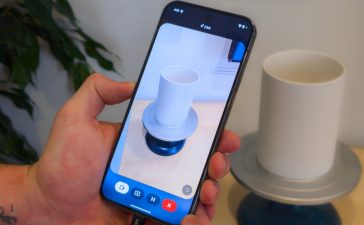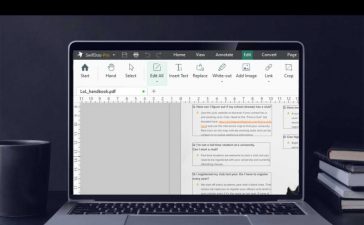Virtual reality, augmented reality, mixed reality, and now Apple’s spatial computing — each has a different meaning. But this proliferation of terms for the same core concept is a sign of a product category that’s regularly remaking itself in an effort to “catch on” — because so far, it hasn’t.
Augmented reality (adding digital elements to a live view) has resonated with various vertical use cases like architecture, education, retail, and industrial design. Virtual reality (a fully immersive virtual experience) has had some successes with gaming and entertainment. For consumer-oriented products, the most recent experience has followed a mixed-reality model (in which AR and VR co-exist), best exemplified by Meta Oculus Quest 3 and now Apple Vision Pro. (The Vision Pro lets the user adjust the intensity between a more immersive experience and a digital representation of the real world known as the pass-through image, which is captured by the headset’s cameras.)
Apple likes to compare the Vision Pro’s chances for mainstream success to the iPhone and iPad, which defined existing product categories and established broad markets. But Vision Pro is a niche product that is at this point optimized for entertainment. As a new computing platform, it’s still in its infancy. That was true initially for the Apple Watch, too; after a decade, it’s at last reached maturity and is living up to many of its original expectations.
Vision Pro appears to be well designed, but from a functionality perspective it’s more evolutionary than revolutionary. It makes some of the same design trade-offs as the Meta Oculus Quest 3: it can run for just two hours on battery and the headset feels heavy to wear. Apple’s decision to tether the battery pack to take some of the weight off your neck is probably the right choice, but it could limit mobility.
And then there’s the price.
Meta’s Oculus Quest line, despite being reasonably priced at around $500, has not been a hit. And even with Apple’s reputation, it’s difficult to imagine Vision Pro’s lofty $3,500 base price becoming a successful mainstream consumer product. Options and accessories are also pricey. Want a storage case for your Vision Pro? That’s $200 from Apple. The belt clip for the battery pack is another $50. The case and clip should be in the box at this price point. You could easily drop another $1,200, or more, on things like memory, AppleCare+, a spare battery, lenses, and the like.
Other pressures, new headwinds
Vision Pro also faces headwinds due to a lack of app support for the headset from Netflix, YouTube, Spotify, and potentially others, including Meta and Google, according to Bloomberg.
An ideal use for Vision Pro would be playing movies while traveling on an airplane or other forms of transportation. But there’s a problem: Netflix, the biggest name in streaming movies, only lets you download and play back movies offline using its app; you can’t do this from a web browser. But Netflix and YouTube declined to make visionOS apps and have actively opted out of allowing their iPad and iPhone apps to support visionOS’ compatibility mode, according to Bloomberg. That leaves would-be Netflix and YouTube users stuck relying on a web browser on the Vision Pro, an obviously less-than-ideal experience.
If more content providers decide to disable the use of their Pad and iPhone apps, Apple could have a problem. Yes, the mixed-reality headset initially sold out when it went on sale Jan. 19, but it’s effectively a proof of concept. It needs app support. According to a Bloomberg video, approximately 250 to 400 native visionOS apps are expected to be available by Friday’s launch date, most provided by independent software makers.
Macstories.net offers a useful list of 46 popular apps and their Vision Pro status: native, compatibility mode, or not available. It apparently turned up no native visionOS apps in the whole bunch, but the Vision Pro App Store won’t go live until launch, so that could change soon. (The site indicates that several Google and Meta apps are listed as having disabled iPad/iPhone compatibility, which sounds like they’re following the lead of Netflix and YouTube.
You can hardly blame Netflix for declining to build Vision Pro apps. For one thing, Apple has its own streaming service in direct competition with Netflix. Moreover, analyst Ming-Chi Kuo estimates that Apple sold just 160,000 to 180,000 Vision Prosbefore shipping dates started to slide. When compared to the 260 million subscribersNetflix has — and the 2.7 billion active monthly subscribers to YouTube — the Vision Pro buyers are just a spit in the bucket.
Netflix co-CEO Greg Peters confirmed in a Jan. 25 interview with Stratechery that his company did consider the small size of the Vision Pro market. “Right now, Apple Vision Pro is so subscale that it’s not particularly relevant to most of our members,” he said. “We have to be careful … that we’re not investing in places that are not yielding a return.”
But Netflix isn’t just declining to invest in an app for the Vision Pro; it has actively disabled its iPad app to prevent it from being used with the Vision Pro.
Another factor is that many app makers are disgruntled right now because of Apple’s continued insistence on levying App Store fees as high as 27%, even on transactions processed outside of their apps.
VisionOS App support is also a problem within Apple. Many Apple apps won’t be developed natively for Vision Pro from the start. The vast majority of the “one million apps” that Apple touted as being available for Vision Pro are largely the existing iPad or iPhone versions using compatibility mode. But it takes native apps to provide the best Vision Pro experience.
The takeaway
With its tethered battery pack and fitment accessories, the Vision Pro is bit clunky, it barely provides enough battery power to watch shorter movies, it lacks app support from key streaming video content providers, and it’s very expensive.
Even so, it’s not all bad news for Apple. The company has put a stake in the ground to establish that, no matter how merely adequate Vision Pro is, Apple still makes the best mixed-reality headset in the land. Apple is almost certainly playing the long game; there will be iterations and price cuts to come. The fact that the word “Pro” in the product name is Apple code for a subsequent model that has fewer tech goodies but is less expensive.
If Apple can fight the uphill battle, it has a chance to succeed with Vision Pro. But if the lack of app support broadens and deepens, it could give Vision Pro a black eye from which it never recovers.
Copyright © 2024 IDG Communications, Inc.












